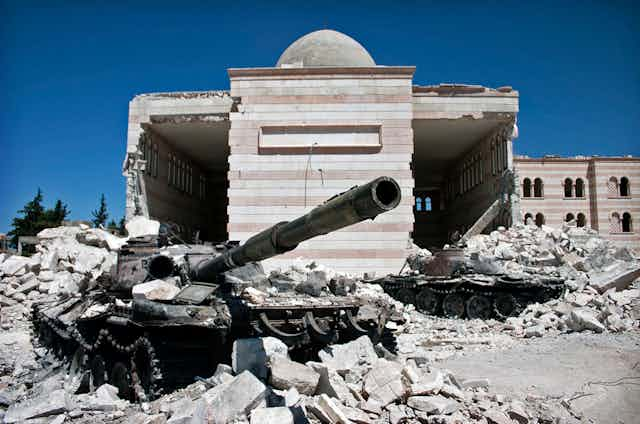The second round of the Geneva II talks on Syria have ended with no agreement and without even a decision on the date of a further meeting. The highly experienced UN mediator, Lakhdar Brahimi, was clearly exasperated at the failure pointing to the disastrous impact of a war which now has no end in sight.
Very limited progress was made last week on the humanitarian side, with some relief for the city of Homs, but it is estimated that there are 250,000 civilians under siege elsewhere in Syria and this is in a country where 135,000 people have died, mostly civilians, and nearly half the population, 9.5m people, have been displaced from their homes.
To add to this, of the two million people who have been displaced not just from their homes but from their country, refugee camps in neighbouring countries are beginning to acquire a look of permanence, with residents increasingly fearing that it will be years before they can return home, if ever.
Regional conflict
These camps combine size with insecurity and make it far easier for radical Islamist groups to move across the borders into Syria, especially from Turkey, and this, in turn, links the conflicts in neighbouring countries. Much of the focus is on Lebanon, but the continued deterioration of security in Iraq is slowly coming into focus.
At least 49 people were killed in bomb attacks in Hilla and Baghdad on 18 Feburary, following bombings the previous day in Baghdad that killed 23. Last month, more than 1,000 people were killed in Iraq, mostly by radical Sunni paramilitaries attacking Shi’a communities, but at the hands of the Iraqi security forces.
Meanwhile the crackdown on Islamists by the Egyptian government has done little to stem their actions and may well stimulate further action. While there have been many attacks in metropolitan Egypt, one of the main focus points has been Sinai – last Sunday a tourist bus was attacked, killing two South Korean tourists and an Egyptian. The attack has since been claimed by the radical Islamist paramilitary group, Ansar Beit al-Maqdis, as part of a campaign against a government branded as “traitors”.
These developments focus western European governments on an element of increasing domestic concern – the return of men who have been fighting for Islamist paramilitary groups, especially in Syria. The British and French governments are most concerned. They see parallels both with the 1980s when foreign fighters against the Soviets in Afghanistan went on to be significant in the al-Qaeda cohorts, and the more recent experience of foreign paramilitaries in Iraq in the last decade.

This factor, especially the increase in Islamist paramilitary competence in Syria, is coming to the forefront of western policy on the war and, in the wake of the Geneva failure, may lead to a subtle and largely unstated change of direction. This stems from an analysis which sees little sign of progress on the diplomatic front, bearing in mind that Russia appears now to have reinforced its commitment to the survival of the Assad regime.
Horns of a dilemma
The western priority is to minimise the risk of a further revival of al-Qaeda-like movements, especially in Syria and Iraq, primarily because of the risk of domestic blowback, but also because of the probable spread of insecurity across the Middle East with its oil and gas.
It is in a quandary, though, because the most commonly mooted solutions are equally problematic and dangerous. One is to acknowledge privately that the Assad regime is unlikely to be defeated unless the radical Islamist elements in the insurgency are provided with far more armaments. Some states, including the Saudis, might be prepared to do this – but the end result would be a totally unacceptable rise in al-Qaeda-linked movements.
An alternative would be to do some kind of deal with the Russians and Iranians, which would see Assad go, but much of his security regime survive. This script provides a basis for considerable aid to a transitional regime that includes the “acceptable” rebels and allows for heavy support for the new government to defeat the Islamists. It might succeed in the short term but it would be a gift to those of a violent Islamist frame of mind who could point to yet one more example of the western “far enemy” encroaching on the Arab-Islamic world.
These possibilities make for a stark reminder of the terrible humanitarian disaster unfolding in Syria, a disaster that may well lead to more short-term attempts at relief yet with no end in sight for the war itself. As of now the “international community” is simply not a community of agreement. One of the fundamental problems of the war is its double proxy aspect, with Saudi Arabia versus Iran one one hand and the US and Europe versus Russia on the other, is rigid.
It is further evidence of the weakness of the UN system which may have a lot of experience in peacekeeping but has never had sufficient support from members to develop its own independent intervention capability. The idea of a UN Emergency Peace Service has been around a long time, advocated by, among others, the Canadian academic Peter Langille, but it has never got off the ground and remains a crucial missing element in international security.
It is possible that the disaster unfolding in Syria will change that, but this is scant comfort for the many millions of people suffering the effects of a war now heading towards its fourth year.
@profprogers

